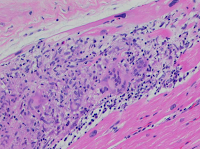Sarcoidosis (from sarc meaning "flesh", -oid, "like", and -osis, "diseased or abnormal condition")
It is a disease in which abnormal collections of chronic inflammatory cells (granulomas) form as nodules in multiple organs.
The cause of sarcoidosis is unknown. The granulomas that appear are usually not of the necrotizing variety and are most often located in the lungs or the lymph nodes, but virtually any organ can be affected.
Causes
The exact cause of sarcoidosis is not known. The current working hypothesis is, in genetically susceptible individuals, sarcoidosis is caused through alteration to the immune response after exposure to an environmental, occupational, or infectious agent.
The exact cause of sarcoidosis is not known. The current working hypothesis is, in genetically susceptible individuals, sarcoidosis is caused through alteration to the immune response after exposure to an environmental, occupational, or infectious agent.
Genetic
Currently, the most interesting candidate gene is BTNL2; several HLA-DR risk alleles are also being investigated. In persistent sarcoidosis, the HLA-B7-DR15 are either cooperating in disease or another gene between these two loci is associated. In non persistent disease, there is a strong genetic association with HLA DR3-DQ2.
Infectious agents
Several infectious agents appear to be significantly associated with sarcoidosis, but none of the known associations is specific enough to suggest a direct causative role.
Examples: propionibactrium acnes,mycobacterium.
Signs and symptoms
Sarcoidosis of the lung is primarily an interstitial lung disease in which the inflammatory process involves the alveoli, small bronchi, and small blood vessels.
About 90% of patients have an abnormal chest X-ray at some time during the course of their disease.
About 50% develop permanent pulmonary abnormalities.
5 to 15% have progressive fibrosis of the lung parenchyma.
Patient may have shortness of breath, a dry, hacking cough, in acute and subacute cases; physical examination usually reveals dry rales.
The most common lesions are: erythema nodosum, maculopapular eruption, subcutaneious nodules, plaques and lupus pernio.
NO treatment required since the lesions resolved within 2-4 weeks.
Liver
Although liver biopsy reveals liver involvement in 60 to 90% of cases, liver dysfunction is usually not important clinically.
Although liver biopsy reveals liver involvement in 60 to 90% of cases, liver dysfunction is usually not important clinically.
About 20–30% has hepatomegaly and/or biochemical evidence of liver involvement.
Usually, these changes reflect a cholestatic pattern and include an elevated alkaline phosphatase level.
The bilirubin and transaminidases are only mildly elevated.
Jaundice is rare.
Heart
20 -30 % cardiac involvement, only 5% symptomatic
Range from asymptomatic conduction abnormalities to fatal ventricular arrhythmia.
Myocardial sarcoidosis can be a rare cause of sudden cardiac death.
Retired hockey played Gaetano Orlando received a "total artificial heart" to replace ventricular damage by sarcoidosis.
Eye
Uveitis, ueoparotitis and retinal inflammation; may result in loss of visual acuity or blindness.
Uveitis, ueoparotitis and retinal inflammation; may result in loss of visual acuity or blindness.
 Uveoparotid fever: a combination of anterior uveitis, parotitis and seventh cranial nerve paralysis and it's associated with Heerfordt-Waldenstorm syndrome.
Uveoparotid fever: a combination of anterior uveitis, parotitis and seventh cranial nerve paralysis and it's associated with Heerfordt-Waldenstorm syndrome.
Development of scleral nodule associated with sarcoidosis has been observed.
Blood
Anemia occurs in 4-20% of cases.
Anemia occurs in 4-20% of cases.
Leukopenia (due to reduced circulatory lymphocytes or lymphopenia) occurs in 40%
Non specific findings: monocytosis, increased hepatic enzymes or alkaline phosphetase, hypercalciuria and hypocalcaemia seen in <10% of cases.
Intrathoracic nodules enlarged in 75-90% of cases (usually those include hilar nodes)
Peripheral lymphadenopathy is very common, especially cervical, axillary and inquinal nodes.
Palpation causes no pain.
Nervous System
Known as neurosarcoidosis
Known as neurosarcoidosis
All component of nervous system can be involved
Cranial nerves are predominantly affected.
The most common neurological manifestation is bilateral facial nerve palsy, usually sudden and transient.
Other common manifestations: potic nerve dysfunction, papilledema, palate dysfunction, hearing abnormalities, hypothalamic-pititary abnormalities, chronic meningitis, and peripheral neuropathy.
Intramedullary sarcoidosis is rare occur in <1% of cases, and initial clinical presentation may be Myelopathy.





